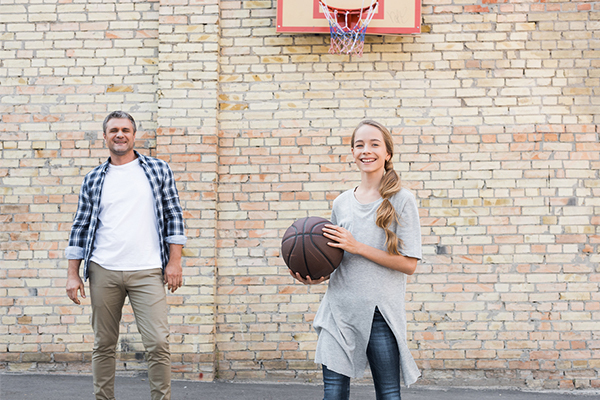If you’re wondering why your child is bouncing off the walls, ask yourself: How much exercise has he or she gotten today?
If social distancing has become one long day of screen time—checking in on schoolwork, catching up with friends, then relaxing in front of a movie—it’s definitely time to get your child up and moving.
Unlike for adults, the main benefit of exercise for kids isn’t for their hearts, although it does play an important role in keeping off weight—especially if your family is starting to gain the “COVID 19” from eating too much junk food or sweets during quarantine.
“The real benefit of physical exercise for kids is improving their ability to mentally focus by burning off extra energy,” said Dr. David Cearley, a pediatric orthopedist at the Children’s Hospital of Georgia. “When they have all this extra energy that’s not being utilized, it comes out as distracted mental energy. Engaging their mind on something physical really helps them calm down and focus.”
So Get Moving
Experts suggest that children be physically active for about 60 minutes every day—but the good news is, it doesn’t have to be super intense and it doesn’t have to be all at once. “It’s important to be realistic, especially during this time,” said Cearley.
Cearley says he and his family of teens like to keep it simple: Recently, they’ve been taking long walks with their dog around their neighborhood. They’ve also been walking or biking public spaces like North Augusta’s Greenway or the Augusta Canal Trail, safely staying six feet away from others. “I think it’s important to remind people that these places are still available to us and are not so crowded that they’re prohibitive,” said Cearley, who also has been renting kayaks with his family to float down Betty’s Branch in Evans.
Whatever you do, it doesn’t have to be groundbreaking—just keep in mind that you want to get your kids moving, says Cearley. Here are a few of his favorite ideas:
Yardwork or gardening. “It’s not only exercise, but also a good way to teach them about nature,” said Cearley. Children of all ages can help rake, weed, water, trim and plant. Lifting and carrying helps build strength, planting helps develop fine motor skills and patience, and mowing the lawn can be a real cardiovascular workout.
Playing HORSE. You can involve the whole family in a friendly game of HORSE around the basketball hoop, or get inspired by ESPN, which recently televised a HORSE competition played over FaceTime by NBA players. Your kids can challenge their friends and, with parents or siblings to film, watch each other’s shots in real time.
Indoor or outdoor hunts. It’s a great time of year to stage an Easter egg hunt—even after Easter is over. Younger kids, especially, may just enjoy the fun of searching for colorful plastic eggs, with or without prizes inside. Or, look online for a huge variety of indoor or outdoor scavenger hunt ideas. Time these events to make them even more challenging, or say that the first person who gets a certain number of items wins.
Bubbles. A bubble machine is a great investment for younger kids. Just set it up on the lawn, and watch them run and jump to catch the bubbles.
Balloon badminton. Set up your sofa as the “net,” and invite kids to hit a balloon back and forth, with racquets if you have them or just with their hands.
Golf. It’s Augusta, after all, and many golf courses are still open. “My son doesn’t even really play golf, but that’s one thing we can do so that we can walk and play and spend time together,” said Cearley.
Then, Move Some More
Getting active playtime in every day is great. Even better is if you can add in some intense exercise for about 20 to 30 minutes, three times a week.
Indoor or outdoor obstacle courses. For an indoor course, just make sure that everything breakable is out of the way, then mark out a course. For example, kids must run through the kitchen, crawl under the dining room table, walk from chair to chair, run around the sofa three times, then whoever touches the back door first wins a prize. Outside, you can do a similar course using trees and outside furniture as markers. Or, using sidewalk chalk, mark out a course or even a maze on the driveway for kids to run or jump through.
Biking. Biking is one way that you and another child can still play “together”—as long as they maintain social distance of six feet. Whether or not your child is responsible enough to do this or if he or she needs supervision is up to you. Children can ride with you on a trail, or you can find an empty parking lot to hold bike races.
CrossFit. CrossFit can be easy to do at home and is a great high-intensity workout, especially for kids who are typically involved in sports and want to maintain their physical fitness until they can play again. For example, “You can get a pullup bar and set it up in door jamb,” said Cearley. “We have one, and our kids use it a lot.” There should also be plenty of objects at home that your child can set up to jump over, or heavy items to carry.
Online workouts. If your child is going to have screen time, why not make it active time? Cearley suggests parents read up on Romper.com’s “10 Online Exercise & Yoga Classes to Make Up for P.E.”—which offers everything from yoga and dance to full-on cardio workouts, all with fun, kid-friendly music and instructors.
Even More Benefits
Right now, even if they aren’t telling you, children and teens may be feeling some anxiety and depression. After all, they’re missing their friends, sports, activities—and maybe even school, although they might not admit it.
“We know that exercise creates a surge of endorphins that elevates mood,” said Cearley. “Children who exercise are better able to cope with their circumstances, have better mood elevation and stabilization, and improved focus and energy.”




